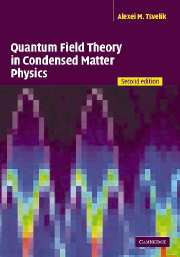Book contents
- Frontmatter
- Contents
- Preface to the first edition
- Preface to the second edition
- Acknowledgements for the first edition
- Acknowledgements for the second edition
- I Introduction to methods
- II Fermions
- III Strongly fluctuating spin systems
- IV Physics in the world of one spatial dimension
- Introduction
- 22 Model of the free bosonic massless scalar field
- 23 Relevant and irrelevant fields
- 24 Kosterlitz–Thouless transition
- 25 Conformal symmetry
- 26 Virasoro algebra
- 27 Differential equations for the correlation functions
- 28 Ising model
- 29 One-dimensional spinless fermions: Tomonaga–Luttinger liquid
- 30 One-dimensional fermions with spin: spin-charge separation
- 31 Kac–Moody algebras: Wess–Zumino–Novikov–Witten model
- 32 Wess–Zumino–Novikov–Witten model in the Lagrangian form: non-Abelian bosonization
- 33 Semiclassical approach to Wess–Zumino–Novikov–Witten models
- 34 Integrable models: dynamical mass generation
- 35 A comparative study of dynamical mass generation in one and three dimensions
- 36 One-dimensional spin liquids: spin ladder and spin S = 1 Heisenberg chain
- 37 Kondo chain
- 38 Gauge fixing in non-Abelian theories: (1 + 1)-dimensional quantum chromodynamics
- Select bibliography
- Index
26 - Virasoro algebra
Published online by Cambridge University Press: 05 May 2010
- Frontmatter
- Contents
- Preface to the first edition
- Preface to the second edition
- Acknowledgements for the first edition
- Acknowledgements for the second edition
- I Introduction to methods
- II Fermions
- III Strongly fluctuating spin systems
- IV Physics in the world of one spatial dimension
- Introduction
- 22 Model of the free bosonic massless scalar field
- 23 Relevant and irrelevant fields
- 24 Kosterlitz–Thouless transition
- 25 Conformal symmetry
- 26 Virasoro algebra
- 27 Differential equations for the correlation functions
- 28 Ising model
- 29 One-dimensional spinless fermions: Tomonaga–Luttinger liquid
- 30 One-dimensional fermions with spin: spin-charge separation
- 31 Kac–Moody algebras: Wess–Zumino–Novikov–Witten model
- 32 Wess–Zumino–Novikov–Witten model in the Lagrangian form: non-Abelian bosonization
- 33 Semiclassical approach to Wess–Zumino–Novikov–Witten models
- 34 Integrable models: dynamical mass generation
- 35 A comparative study of dynamical mass generation in one and three dimensions
- 36 One-dimensional spin liquids: spin ladder and spin S = 1 Heisenberg chain
- 37 Kondo chain
- 38 Gauge fixing in non-Abelian theories: (1 + 1)-dimensional quantum chromodynamics
- Select bibliography
- Index
Summary
In this chapter I continue to study the group of conformal transformations of the complex plane. The exposition of this and the following chapter is based on the pioneering paper by Belavin et al. (1984). Naturally, such studies are hardly necessary for the Gaussian model where one can calculate the correlation functions directly. However, these general considerations become indispensable in more complicated cases.
In two dimensions the group of conformal transformations is isomorphic to the group of analytic transformations of the complex plane. Since the number of analytic functions is infinite, this group is infinite-dimensional, i.e. has an infinite number of generators. An infinite number of generators generates an infinite number ofWard identities for correlation functions. These identities serve as differential equations on correlation functions. No matter how many operators you have in your correlation function, you always have enough Ward identities to specify it. Thus in conformally invariant theories (for brevity we shall call them ‘conformal’ theories) one can (at least in principle) calculate all multi-point correlation functions. We have already calculated multi-point correlation functions of the bosonic exponents for the Gaussian model; below we shall see less trivial examples.
Let us take in good faith that there are models besides the Gaussian one whose spectrum is linear, whose correlation functions factorize into products of analytic and antianalytic parts and which have operators transforming under analytic (antianalytic) transformations like (25.4). Such operators will be called primary fields.
- Type
- Chapter
- Information
- Quantum Field Theory in Condensed Matter Physics , pp. 226 - 232Publisher: Cambridge University PressPrint publication year: 2003

